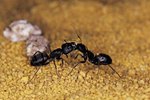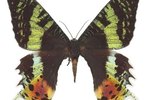
Mutualism refers to a mutually beneficial relationship between two species where both receive benefit from the other. One example would be a cowbird eating pesky parasites off the back of a bovine. The cow is freed from parasites and the bird gets a meal. Butterflies also have mutualistic relationships with other species, including flowers and ants.
Mutualism and Symbiosis
Butterflies are commonly said to have a symbiotic relationship with flowers. Mutualism is just one of three types of symbiosis and is characterized by each species receiving a specific benefit from the other. A parasitic relationship -- such as ticks on a dog -- involves one party receiving the benefit at the cost of the other. A commensal relationship benefits one species with no affect to the other, such as vultures cleaning up remains of a lion kill.
Butterfly Food
Adult butterflies feast on the nectar provided by flowers, drawing it in through a long straw-like proboscis. While they are drinking, the flower's pollen clings to their feet and legs, being transferred to other flowers as they feed from flower to flower. In cooler climates, the flowers provide the butterfly with a warm place to rest, a feature that is particularly noticed in solar-tracking flowers that turn their blooms toward the sun as it moves through the sky.
Ant Farming
The caterpillar of the blue Maculinea arion secretes pheromones that entice a species of red ant to carry it back to its nest. The caterpillar feeds on the ant grubs, while adult ants stroke it to obtain a sugary substance from its dorsal gland. The butterfly emerges from its pupal stage inside the ant colony, emitting another pheromone that calms the ants and permits it to leave unmolested to dry its wings and fly away.
Toxic Relationships
Some species of plants have developed toxins designed to kill caterpillars as they devour leaves and stems. Some butterfly species -- like the tiger butterfly in the Amazon -- benefit from these toxins by storing them in their bodies to make them poisonous to birds. These species usually have especially brilliant colors to warn birds of the toxins contained within. Other butterfly species have developed near-identical wing patterns that mimic poisonous species with little or no poison of their own.
References
Photo Credits
-
Thinkstock/Comstock/Getty Images
Writer Bio
Indulging her passion for vacation vagary through the written word on a full-time basis since 2010, travel funster Jodi Thornton-O'Connell guides readers to the unexpected, quirky, and awe-inspiring.




